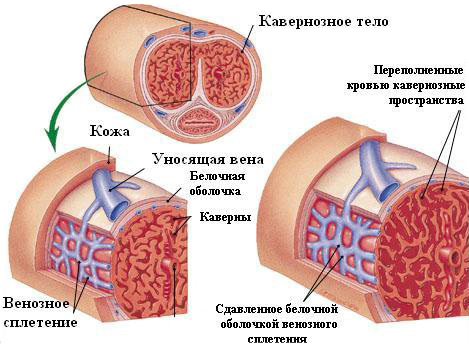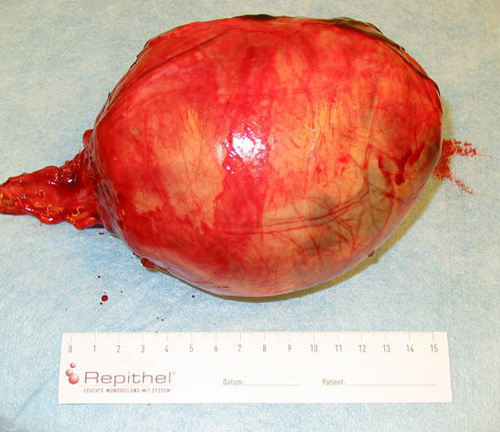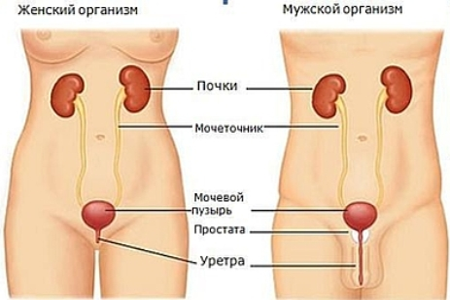Erectile dysfunction of vascular genesis
The term erectile dysfunction determines the impossibility of a full sexual intercourse due to an insufficient or missing erection of the penis in a man who has a periodic or permanent character. This pathological condition develops due to the influence of various etiological( causative) factors( psychological factors, hormonal disorders, anatomical deformation of the cavernous bodies of the penis).The most common cause( up to 70% of all cases of this pathology) are vascular disorders.
Contents
- 1 Definition and development mechanism
- 2 Why does it occur?
- 2.1 Risk Factors
- 3 Diagnostic Methods for Vascular Pathology
- 4 Treatment
Definition and Mechanism of Development
Vascular vasculogenic erectile dysfunction is a violation of potency associated with organic or functional changes in the vessels of the penis of a man. Erection is a complex physiological process, during which during sexual stimulation there is a restriction of outflow of blood through the veins, by reducing the sphincters, with an increased influx through the arteries, which leads to the filling of cavernous bodies, increase of pressure in them, increase of the penis in the volume, andAlso the acquisition of the firmness necessary for a full sexual intercourse. In vascular disorders, there is insufficient blood flow or a decrease in the tone of the sphincter regulating its outflow, which causes an insufficient increase in the volume of cavernous bodies.

Fig.1 - The mechanism of erection.
Why does it occur?
Vascular erectile dysfunction develops due to 2 groups of causes:
- infringement of arterial blood flow to the cavernous bodies of the penis;
- increases the outflow of blood during an erection from the cavernous bodies of the penis as a result of a decrease in the functional activity of venous sphincters, which during the erection maintain blood pressure in the cavernous( cavernous) bodies.
The causes of abnormal blood flow with occlusion( a decrease in lumen) of the arterial vessels of the penis are:
- Systemic atherosclerosis is a pathological condition in which cholesterol is deposited in the walls of the arteries with the formation of atherosclerotic plaques, which cause a decrease in the lumen of the vessels. This cause of vascular erectile dysfunction is the most frequent, it occurs in 90% of cases.
- Diabetes mellitus is an exchange disorder characterized by an increase in the level of sugar in the body of a man and systemic impairments in the functional activity of arterial vessels.
- Reduction of the pumping function of the heart for ischemic disease, cardiosclerosis, after myocardial infarction, leading to a decrease in the volume of blood flow into the cavernous bodies of the penis.
- Hypertensive disease is a prolonged increase in systemic arterial pressure, leading to organic changes in arterial vessels, including cavernous bodies.
- Local changes in the arterial vessels of the penis and pelvis, which are a consequence of the suffered abdominal and groin injuries - this cause of vascular erectile dysfunction is most often found in young men under 40 years old.
Virtually all causes of insufficient blood flow to the cavernous bodies of the penis affect men over 40 years of age, leading to a higher incidence of potency disorders. Violation of the functional activity of venous sphincters, which increases the flow of blood during erection from the cavernous bodies of the penis, which leads to a decrease in pressure in them( venous leakage), develops for several main reasons:
- Increased lumen of the veins, which can be primary( takes place when the hereditary factor is realized) and secondary( passion for spicy food, smoking, systematic use of alcohol).
- Degenerative changes in the belly coat( the covering covering the cavernous bodies), resulting in insufficient closure of the venous sphincters - such changes are most often determined in elderly men, against the backdrop of Peyronie's disease( the curvature of the penis due to sclerotic changes in cavernous bodies and the belly coat), Suffered injuries to the perineal region, as well as diabetes mellitus.
- Organic changes in the inner layer of venous vessels, which are the result of injuries, increased lipid levels in the blood( hyperlipidemia), age involution( extinction of the functional activity of the reproductive system).
- The formation of venous shunts, by which the blood is discharged bypassing the sphincters, after the surgical interventions on the structures of the genitourinary system.
- Disturbance of contractility of smooth muscles of sphincters due to impairment of innervation or organic changes.
Risk Factors
Most causes of vascular pathology are the result of the influence of provoking factors affecting the condition of the arteries, veins and cavernous bodies of the penis. These factors include:
- Age of a man - a violation of potency is more likely to develop in men older than 40-50 years, which is associated with age-related involution of the reproductive system, as well as the gradual decompensation of chronic cardiovascular pathology.
- Harmful habits - alcohol, nicotine are vascular toxins, they have a negative effect on the walls of the arteries, leading to a gradual decrease in their clearance with the development of occlusion.
- Sedentary lifestyle - low motor activity is one of the main reasons for the development of cardiovascular pathology, including the defeat of the arteries of the penis.
- The prevalence in the diet of a man of fatty, fried and spicy food, which has a negative effect on the condition of venous vessels and sphincters of the penis of a man.
- Various suffered traumas with their localization in the lower abdomen and perineum.
Table 1 - Proved risk factors for the development of erectile dysfunction( MMAS, 2005).

Knowledge of the causes of vascular erectile dysfunction, as well as the impact of risk factors help to choose the most optimal and effective treatment for this disorder.
Diagnostics of vascular pathology
Diagnosis of vascular erectile dysfunction includes a comprehensive examination of the body of a man using various methods of laboratory, instrumental and functional research, including:
- Biochemical blood test with determination of cholesterol and lipid profile - allows to diagnose atherosclerosis.
- Electrocardiogram( ECG) is a functional study of the electrical activity of the heart that makes it possible to detect a decrease in its pumping function( arrhythmias, ischemic disease, and myocardial infarction).
- Ultrasound examination of the vessels of the penis with dopplerography at rest and after stimulation of the erection is one of the main diagnostic methods, it is an instrumental study with ultrasound visualization of the blood flow condition.
Based on the results of additional diagnostic studies, the doctor makes a conclusion about the causes of the development of erectile dysfunction, as well as the degree of vascular disorders.
Treatment of
Treatment of vascular erectile dysfunction is complex. It primarily includes therapeutic measures aimed at improving blood flow in the cavernous bodies of the penis, their choice depends on the diagnosed cause of the development of a violation of potency. The main methods of treatment include the use of various drugs, surgery and physiotherapy. The use of drugs, the choice of which depends on the causes of vascular erectile dysfunction, includes several pharmacological groups of medicines:
- inhibitors of phosphodiesterase 5( PDE 5), - means of blocking the enzyme phosphodiesterase, resulting in the cavernous bodies of the penis accumulates compound cGMP( cyclic guanine monophosphate), which leads to a reduction of tone of smooth muscle and dilation of the arteries, thereby increasing blood volumeAnd erections. The main representative of this group is sildenafil( Viagra, Konegra).He improves an erection only with the presence of a man's sexual stimulation. Sildenafil and its analogs do not eliminate the main cause of vascular erectile dysfunction. Static
- ( simvastatin) - drugs that reduce cholesterol levels in the blood, thereby preventing the formation of atherosclerotic plaques and atherosclerosis. These drugs are used to improve the condition of arteries in atherosclerosis.
- antispasmodics( papaverine) - reduces the tone of smooth muscles of arteries, contribute to the filling of the corpora cavernosa with blood.
- The blockers of alpha1-adrenergic receptors - also contribute to a decrease in the tone of the arteries.
The majority of pharmacological agents for the treatment of vascular erectile dysfunction increase blood flow in the cavernous bodies. In case of failure of therapy using the medicaments may be carried out surgical interventions for plastic reconstruction of the vascular system corpora cavernosa and the tunica albuginea of the penis. In the complex treatment of vascular disorders, physiotherapy is used to improve erection. The most common and effective method of physiotherapy is the use of a local negative effect( LOD-therapy).
GP Krivoguz IM
Recommended viewing:



